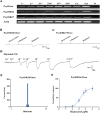An odorant receptor mediates the avoidance of Plutella xylostella against parasitoid
- PMID: 38475722
- PMCID: PMC10935965
- DOI: 10.1186/s12915-024-01862-9
An odorant receptor mediates the avoidance of Plutella xylostella against parasitoid
Abstract
Background: Ecosystems are brimming with myriad compounds, including some at very low concentrations that are indispensable for insect survival and reproduction. Screening strategies for identifying active compounds are typically based on bioassay-guided approaches.
Results: Here, we selected two candidate odorant receptors from a major pest of cruciferous plants-the diamondback moth Plutella xylostella-as targets to screen for active semiochemicals. One of these ORs, PxylOR16, exhibited a specific, sensitive response to heptanal, with both larvae and adult P. xylostella displaying heptanal avoidance behavior. Gene knockout studies based on CRISPR/Cas9 experimentally confirmed that PxylOR16 mediates this avoidance. Intriguingly, rather than being involved in P. xylostella-host plant interaction, we discovered that P. xylostella recognizes heptanal from the cuticular volatiles of the parasitoid wasp Cotesia vestalis, possibly to avoid parasitization.
Conclusions: Our study thus showcases how the deorphanization of odorant receptors can drive discoveries about their complex functions in mediating insect survival. We also demonstrate that the use of odorant receptors as a screening platform could be efficient in identifying new behavioral regulators for application in pest management.
Keywords: Plutella xylostella; Avoidance behavior; Heptanal; Odorant receptor; Parasitoid wasp.
© 2024. The Author(s).
Conflict of interest statement
The authors declare that they have no competing interests.
Figures





Similar articles
-
Characterization of larval gut microbiota of two endoparasitoid wasps associated with their common host, Plutella xylostella (Linnaeus) (Lepidoptera: Plutellidae).Microbiol Spectr. 2024 Oct 3;12(10):e0120824. doi: 10.1128/spectrum.01208-24. Epub 2024 Sep 9. Microbiol Spectr. 2024. PMID: 39248477 Free PMC article.
-
Identification of floral volatiles from Fagopyrum esculentum that attract Cotesia vestalis with potentially better biocontrol efficacy against Plutella xylostella.Pest Manag Sci. 2024 Feb;80(2):763-775. doi: 10.1002/ps.7808. Epub 2023 Oct 11. Pest Manag Sci. 2024. PMID: 37774133
-
Synchronous Occurrences of the Diamondback Moth (Lepidoptera: Plutellidae) and its Parasitoid Wasp Cotesia vestalis (Hymenoptera: Braconidae) in Greenhouses in a Satoyama Area.Environ Entomol. 2020 Feb 17;49(1):10-14. doi: 10.1093/ee/nvz140. Environ Entomol. 2020. PMID: 31773136
-
Genetic control of Plutella xylostella in omics era.Arch Insect Biochem Physiol. 2019 Nov;102(3):e21621. doi: 10.1002/arch.21621. Epub 2019 Sep 20. Arch Insect Biochem Physiol. 2019. PMID: 31538676 Review.
-
Identification of microRNAs from Plutella xylostella larvae associated with parasitization by Diadegma semiclausum.Insect Biochem Mol Biol. 2013 Apr;43(4):309-18. doi: 10.1016/j.ibmb.2013.01.004. Epub 2013 Jan 23. Insect Biochem Mol Biol. 2013. PMID: 23352895 Review.
Cited by
-
Functional Characterization of an Odorant Receptor Expressed in Newly Hatched Larvae of Fall Armyworm Spodoptera frugiperda.Insects. 2024 Jul 26;15(8):564. doi: 10.3390/insects15080564. Insects. 2024. PMID: 39194769 Free PMC article.
-
The Utility of Visual and Olfactory Maize Leaf Cues in Host Finding by Adult Spodoptera frugiperda (Lepidoptera: Noctuidae).Plants (Basel). 2024 Nov 25;13(23):3300. doi: 10.3390/plants13233300. Plants (Basel). 2024. PMID: 39683094 Free PMC article.
-
Volatiles of the Predator Xylocoris flavipes Recognized by Its Prey Tribolium castaneum (Herbst) and Oryzaephilus surinamensis (Linne) as Escape Signals.Insects. 2024 Dec 31;16(1):31. doi: 10.3390/insects16010031. Insects. 2024. PMID: 39859612 Free PMC article.
-
Identification of miRNAs Involved in Olfactory Regulation in Antennae of Beet Webworm, Loxostege sticticalis (Lepidoptera: Pyralidae).Life (Basel). 2024 Dec 23;14(12):1705. doi: 10.3390/life14121705. Life (Basel). 2024. PMID: 39768411 Free PMC article.
-
CRISPR/Cas9 Genome Editing in the Diamondback Moth: Current Progress, Challenges, and Prospects.Int J Mol Sci. 2025 Feb 11;26(4):1515. doi: 10.3390/ijms26041515. Int J Mol Sci. 2025. PMID: 40003981 Free PMC article. Review.
References
-
- Payne TL, Kennedy CEJ. Insect chemoreception. (book reviews: mechanisms in insect olfaction). Science. 1987;236(4799):341. - PubMed
MeSH terms
Substances
Grants and funding
LinkOut - more resources
Full Text Sources

